Insecticidal Activity of Lectin Preparations from Moringa oleifera Lam. (Moringaceae) Seeds Against Alphitobius diaperinus (Panzer) (Coleoptera: Tenebrionidae)
Abstract
1. Introduction
2. Results
3. Discussion
4. Conclusions
5. Materials and Methods
5.1. Insects
5.2. Moringa oleifera Seed Preparations
5.3. Evaluation of Contact Toxicity on A. diaperinus Larvae and Adults
5.4. Ingestion Toxicity Assay in Adults
5.5. Effects on the Activity of Trypsin-like Enzymes
5.6. Midgut Histological Analysis
5.7. Statistical Analysis
Author Contributions
Funding
Data Availability Statement
Conflicts of Interest
References
- Tremea, F.T.; Silva, A.C. O setor avícola no Brasil e sua distribuição regional. Econ. Região 2020, 8, 183–200. [Google Scholar] [CrossRef]
- Rueda, L.M.; Axtell, R.C. Temperature-dependent development and survival of the lesser mealworm, Alphitobius diaperinus. Med. Vet. Entomol. 1996, 10, 80–86. [Google Scholar] [CrossRef] [PubMed]
- Wilson, T.H.; Miner, F.D. Influence of temperature on development of the lesser mealworm, Alphitobius diaperinus (Coleoptera: Tenebrionidae). J. Kans. Entomol. Soc. 1969, 42, 294–303. [Google Scholar]
- Sammarco, B.C.; Hinkle, N.C.; Crossley, M.S. Biology and Management of Lesser Mealworm Alphitobius diaperinus (Coleoptera: Tenebrionidae) in Broiler Houses. J. Integr. Pest Manag. 2023, 14, 2. [Google Scholar] [CrossRef]
- Hopkins, J.D.; Steelman, C.D.; Carlton, C.E. Anatomy of the adult female lesser mealworm Alphitobius diaperinus (Coleoptera: Tenebrionidae) reproductive system. J. Kans. Entomol. Soc. 1992, 65, 299–307. [Google Scholar]
- Schmidt, G.S.; Abreu, P.G. Manejo integrado para o controle do cascudinho (Alphitobius diaperinus) na produção de frangos de corte. Avic. Ind. 2023, 5, 14–22. [Google Scholar]
- Gazoni, F.L.; Flores, F.; Bampi, R.A.; Silveira, F.; Boufleur, R.; Lovato, M. Avaliação da resistência do cascudinho (Alphitobius diaperinus) (Panzer) (Coleoptera: Tenebrionidae) a diferentes temperaturas. Arq. Inst. Biol. 2012, 79, 69–74. [Google Scholar] [CrossRef]
- Fairchild, B.; Czarick, M.; Hinkle, N. Darkling beetles… costs and control. Poult. Hous. Tips 2005, 17, 12. [Google Scholar]
- Wolf, J.; Potrich, M.; Lozano, E.R.; Gouvea, A.; Pegorini, C.S. Combined physical and chemical methods to control lesser mealworm beetles under laboratory conditions. Poult. Sci. 2015, 94, 1145–1149. [Google Scholar] [CrossRef] [PubMed]
- Gill, H.K.; Garg, H. Pesticide: Environmental Impacts and Management Strategies. In Pesticides-Toxic Effects, 1st ed.; Larramendy, M.L., Soloneski, S., Eds.; InTech: Rijeka, Croatia, 2014; pp. 187–230. [Google Scholar]
- Demirak, M.Ş.Ş.; Canpolat, E. Plant-Based Bioinsecticides for Mosquito Control: Impact on Insecticide Resistance and Disease Transmission. Insects 2022, 13, 162. [Google Scholar] [CrossRef]
- Napoleão, T.H.; Albuquerque, L.P.; Santos, N.D.L.; Nova, I.C.V.; Lima, T.A.; Paiva, P.M.G.; Pontual, E.V. Insect midgut structures and molecules as targets of plant-derived protease inhibitors and lectins. Pest Manag. Sci. 2019, 75, 1212–1222. [Google Scholar] [CrossRef] [PubMed]
- Paul, S.; Das, S. Natural insecticidal proteins, the promising bio-control compounds for future crop protection. Nucleus 2021, 64, 7–20. [Google Scholar] [CrossRef]
- Coelho, J.S.; Santos, N.D.L.; Napoleão, T.H.; Gomes, F.S.; Ferreira, R.S.; Zingali, R.B.; Coelho, L.C.B.B.; Leite, S.P.; Navarro, D.M.A.F.; Paiva, P.M.G. Effect of Moringa oleifera lectin on development and mortality of Aedes aegypti larvae. Chemosphere 2009, 77, 934–938. [Google Scholar] [CrossRef]
- Agra-Neto, A.C.; Napoleão, T.H.; Pontual, E.V.; Santos, N.D.L.; Luz, L.A.; Oliveira, C.M.F.; Melo-Santos, M.A.V.; Coelho, L.C.B.B.; Navarro, D.M.A.F.; Paiva, P.M.G. Effect of Moringa oleifera lectins on survival and enzyme activities of Aedes aegypti larvae susceptible and resistant to organophosphate. Parasitol. Res. 2014, 113, 175–184. [Google Scholar] [CrossRef]
- Santos, N.D.L.; Moura, K.S.; Napoleão, T.H.; Santos, G.K.N.; Coelho, L.C.B.B.; Navarro, D.M.A.F.; Paiva, P.M.G. Oviposition-stimulant and ovicidal activities of Moringa oleifera lectin on Aedes aegypti. PLoS ONE 2012, 7, e44840. [Google Scholar] [CrossRef] [PubMed][Green Version]
- Alves, R.R.V.; Soares, T.; Bento, E.F.L.; Roldan Filho, R.S.; Souza, B.S.S.; Lima, M.K.N.; Nascimento, J.S.; Coelho, L.C.B.B.; Sá, R.A.; Lima, T.A.; et al. Ovicidal lectins from Moringa oleifera and Myracrodruon urundeuva cause alterations in chorionic surface and penetrate the embryos of Aedes aegypti eggs. Pest Manag. Sci. 2020, 76, 730–736. [Google Scholar] [CrossRef]
- Santos, N.D.L.; Paixão, K.S.; Napoleão, T.H.; Trindade, P.B.; Pinto, M.R.; Coelho, L.C.B.B.; Eiras, A.E.; Navarro, D.M.A.F.; Paiva, P.M.G. Evaluation of Moringa oleifera seed lectin in traps for the capture of Aedes aegypti eggs and adults under semi-field conditions. Parasitol. Res. 2014, 113, 1837–1842. [Google Scholar] [CrossRef] [PubMed]
- Silva, L.L.S.; Santos, N.D.L.; Silva, S.C.C.; Lima, T.A.; Coelho, L.C.B.B.; Zingali, R.B.; Navarro, D.M.A.F.; Napoleão, T.H.; Paiva, P.M.G. Investigation of the ability of the oviposition-stimulant lectin from Moringa oleifera seeds (WSMoL) to bind with membrane proteins present in the legs of Aedes aegypti. Int. J. Biol. Macromol. 2020, 162, 657–662. [Google Scholar] [CrossRef] [PubMed]
- Oliveira, C.F.R.; Moura, M.C.; Napoleão, T.H.; Paiva, P.M.G.; Coelho, L.C.B.B.; Macedo, M.L.R. A chitin-binding lectin from Moringa oleifera seeds (WSMoL) impairs the digestive physiology of the Mediterranean flour larvae, Anagasta kuehniella. Pestic. Biochem. Physiol. 2017, 142, 67–76. [Google Scholar] [CrossRef] [PubMed]
- Liu, Z.L.; Goh, S.H.; Ho, S.H. Screening of Chinese medicinal herbs for bioactivity against Sitophilus zeamais Motschulsky and Tribolium castaneum (Herbst). J. Stored Prod. Res. 2007, 43, 290–296. [Google Scholar] [CrossRef]
- Anjum, B.; Thakuri, S.C.; Panwar, M.; Jahan, T.; Juyal, V.K.; Rashmi; Nand, V. Global current scenario and future prospectus of biorationals. In Biorationals and Biopesticides, 1st ed.; Kumar, R., Oliveira, M.S., Andrade, E.H.A., Suyal, D.C., Soni, R., Eds.; De Grutyer: Berlin, Germany, 2024; pp. 23–46. [Google Scholar]
- Rezende, S.R.F.; Curvello, F.A.; Fraga, M.E.; Reis, R.C.S.; Castilho, A.M.C.; Agostinho, T.S.P. Control of the Alphitobius diaperinus (Panzer) (Coleoptera: Tenebrionidae) with Entomopathogenic Fungi. Braz. J. Poult. Sci. 2009, 11, 121–127. [Google Scholar] [CrossRef]
- Volpato, A.; Galli, G.M.; Campigotto, G.; Glombowsky, P.; Santos, R.C.V.; Silva, A.S.; Vaucher, R.A. Avaliação in vitro dos efeitos inseticida e larvicida de oito óleos essenciais sobre o cascudinho aviário (Alphitobius diaperinus). Arch. Vet. Sci. 2018, 23, 84–90. [Google Scholar] [CrossRef]
- Prado, G.P.; Stefani, L.M.; Silva, A.S.; Smaniotto, L.F.; Garcia, F.R.; Moura, N.F. Alphitobius diaperinus (Coleoptera: Tenebrionidae) susceptibility to Cunila angustifolia essential oil. J. Med. Entomol. 2013, 50, 1040–1045. [Google Scholar] [CrossRef] [PubMed]
- Santos, N.D.L.; Albuquerque, L.P.; Amorim, M.M.R.; Silva, J.N.O.; Procópio, T.F.; Santos, P.É.M.; Paiva, P.M.G.; Barros, M.R.; Napoleão, T.H.; Pontual, E.V. Effects of Lectin Preparations from Microgramma vacciniifolia Rhizomes on the Survival, Digestive Enzymes, and Acetylcholinesterase Activity of Alphitobius diaperinus (Panzer) (Coleoptera: Tenebrionidae). Macromol 2023, 3, 451–462. [Google Scholar] [CrossRef]
- Moura, K.S.; Silva, H.R.C.; Dornelles, L.P.; Coelho, L.C.B.B.; Napoleão, T.H.; Oliveira, M.D.L.; Paiva, P.M.G. Coagulant activity of water-soluble Moringa oleifera lectin is linked to lowering of electrical resistance and inhibited by monosaccharides and magnesium ions. Appl. Biochem. Biotechnol. 2016, 180, 1361–1371. [Google Scholar] [CrossRef]
- Oliveira, A.P.S.; Agra-Neto, A.C.; Pontual, E.V.; Lima, T.A.; Vera-Cruz, K.C.; Melo, K.R.; Oliveira, A.S.; Coelho, L.C.B.B.; Ferreira, M.R.A.; Soares, L.A.L.; et al. Evaluation of the insecticidal activity of Moringa oleifera seed extract and lectin (WSMoL) against Sitophilus zeamais. J. Stored Prod. Res. 2020, 87, 101615. [Google Scholar] [CrossRef]
- Widiyaningrum, P.; Setiati, N.; Ngabekti, S.; Ngaini, F.; Yuliyanti, T.D.; Hardiyanto, Y. Efficacy of local Ageratum conyzoides leaf extracts on controlling the poultry pest Alphitobius diaperinus (Coleoptera: Tenebrionidae). Sci. Technol. Asia 2023, 28, 169–180. [Google Scholar]
- Santana, C.B.; Souza, J.G.L.; Toledo, A.G.; Alves, L.F.A.; Alves, D.S.; Corrêa, J.M.; Pinto, F.G.S. Antimicrobial and insecticidal effects of essential oil and plant extracts of Myrcia oblongata DC in pathogenic bacteria and Alphitobius diaperinus. Braz. J. Biol. 2022, 82, e233425. [Google Scholar] [CrossRef] [PubMed]
- Punia, A.; Chauhan, N.S.; Kaur, S.; Sohal, S.K. Effect of ellagic acid on the larvae of Spodoptera litura (Lepidoptera:Noctuidae) and its parasitoid Bracon hebetor (Hymenoptera:Braconidae). J. Asia Pac. Entomol. 2020, 23, 660–665. [Google Scholar] [CrossRef]
- Wang, L.; Xu, D.; Yang, Y.; Liu, W.; Cong, S.; Li, W.; Yang, N.; Yin, H.; Jin, L.; Wu, H.; et al. Impact of rutin on growth, development and oviposition of Bt-susceptible and Bt-resistant pink bollworm. Entomol. Res. 2024, 54, e12702. [Google Scholar] [CrossRef]
- Albuquerque, L.P.; Santana, G.M.S.; Pontual, E.V.; Napoleão, T.H.; Coelho, L.C.B.B.; Paiva, P.M.G. Effect of Microgramma vaccinifolia rhizome lectin on survival and digestive enzymes of Nasutitermes corniger (Isoptera, Termitidae). Int. Biodeter. Biodegr. 2012, 75, 158–166. [Google Scholar] [CrossRef]
- El-Aswad, A.F.; Aisu, J.; Khalifa, M.H. Biological activity of tannins extracts from processed Camellia sinensis (black and green tea), Vicia faba and Urtica dioica and Allium cepa essential oil on three economic insects. J. Plant Dis. Protec. 2023, 130, 495–508. [Google Scholar] [CrossRef]
- Bartling, M.T.; Brandt, A.; Hollert, H.; Vilcinskas, A. Current Insights into Sublethal Effects of Pesticides on Insects. Int. J. Mol. Sci. 2024, 25, 6007. [Google Scholar] [CrossRef]
- Müller, T.; Prosche, A.; Müller, C. Sublethal insecticide exposure affects reproduction, chemical phenotype as well as offspring development and antennae symmetry of a leaf beetle. Environ. Pollut. 2017, 230, 709–717. [Google Scholar] [CrossRef] [PubMed]
- Gliszczynska, A.; Dancewicz, K.; Hnatejko, M.; Szczepanikc, M.; Gabrysb, B. Synthesis of β-damascone derivatives with a lactone ring and their feeding deterrent activity against aphids and lesser mealworms. RSC Adv. 2014, 4, 39248. [Google Scholar] [CrossRef]
- Riddick, E.W. Evaluating the Effects of Flavonoids on Insects: Implications for Managing PestsWithout Harming Beneficials. Insects 2024, 15, 956. [Google Scholar] [CrossRef] [PubMed]
- Lazarević, J.; Janković-Tomanić, M. Dietary and phylogenetic correlates of digestive trypsin activity in insect pests. Entomol. Exp. Appl. 2015, 157, 123–151. [Google Scholar] [CrossRef]
- Rocha, L.L.V.; Neves, C.A.; Zanuncio, J.C.; Serrão, J.E. Digestive cells in the midgut of Triatoma vitticeps (Stal, 1859) in different starvation periods. Comptes Rendus Biol. 2010, 333, 405–415. [Google Scholar] [CrossRef]
- Nardi, J.B.; Bee, C.M. Regenerative Cells and the Architecture of Beetle Midgut Epithelia. J. Morphol. 2012, 273, 1010–1020. [Google Scholar] [CrossRef]
- Haddi, K.; Turchen, L.M.; Jumbo, L.O.V.; Guedes, R.N.; Pereira, E.J.; Aguiar, R.W.; Oliveira, E.E. Rethinking biorational insecticides for pest management: Unintended effects and consequences. Pest Manag. Sci. 2020, 76, 2286–2293. [Google Scholar] [CrossRef]
- Silva, L.L.S.; Alves, R.N.; Paulo, D.V.; Silva, J.D.F.; Oliveira, A.P.S.; Coelho, L.C.B.B.; Navarro, D.M.A.F.; Napoleão, T.H.; Amaral, I.P.G.; Carvalho, P.S.M.; et al. Ecotoxicity of water-soluble lectin from Moringa oleifera seeds to zebrafish (Danio rerio) embryos and larvae. Chemosphere 2017, 185, 178–182. [Google Scholar] [CrossRef]
- Brito, J.S.; Marinho, A.O.; Coelho, L.C.B.B.; Oliveira, A.M.; Paiva, P.M.G.; Patriota, L.L.S.; Napoleão, T.H. Toxicity and antitumor activity of the water-soluble lectin from Moringa oleifera Lam. seeds (WSMoL) in sarcoma 180-bearing mice. Toxicon 2023, 234, 107306. [Google Scholar] [CrossRef]
- Green, A.A.; Hughes, L. Methods in Enzymology; Academic Press: New York, NY, USA, 1955; pp. 67–90. [Google Scholar]
- Lowry, O.H.; Rosebrough, N.J.; Farr, A.L.; Randall, R.J. Protein measurement with the Folin phenol reagent. J. Biol. Chem. 1951, 193, 265–275. [Google Scholar] [CrossRef]
- Procópio, T.F.; Patriota, L.L.S.; Moura, M.C.; Silva, P.M.; Oliveira, A.P.S.; Carvalho, L.V.N.; Lima, T.A.; Soares, T.; Silva, T.D.; Coelho, L.C.B.B.; et al. CasuL: A new lectin isolated from Calliandra surinamensis leaf pinnulae with cytotoxicity to cancer cells, antimicrobial activity and antibiofilm effect. Int. J. Biol. Macromol. 2017, 98, 419–429. [Google Scholar] [CrossRef] [PubMed]
- Bing, D.H.; Weyand, J.G.M.; Stavitsky, A.B. Hemagglutination with aldehyde fixed erythrocytes for assay of antigens and antibodies. Proc. Soc. Exp. Biol. Med. 1967, 124, 1166–1170. [Google Scholar] [CrossRef]
- Zafeiriadis, S.; Sakka, M.K.; Athanassiou, C.G. Efficacy of contact insecticides for the control of the lesser mealworm. Alphitobius diaperinus (Panzer) (Coleoptera: Tenebrionidae). J. Stored Prod. Res. 2021, 92, 101817. [Google Scholar]
- Rice, S.J.; Lambkin, T.A. A new culture method for lesser mealworm, Alphitobius diaperinus. J. Appl. Entomol. 2009, 133, 67–72. [Google Scholar] [CrossRef]
- Isman, M.B.; Koul, O.; Luczynski, A.; Kaminski, J. 90. Insecticidal and antifeedant bioactivities of neem oils and their relationship to azadirachtin content. J. Agric. Food Chem. 1990, 38, 1406–1411. [Google Scholar] [CrossRef]
- Kakade, M.L.; Rackis, J.J.; Mcghee, J.G. An evaluation of natural vs. synthetic substracts for measuring the anti tryptic activity of soy bean samples. Cereal Chem. 1969, 46, 518–526. [Google Scholar]
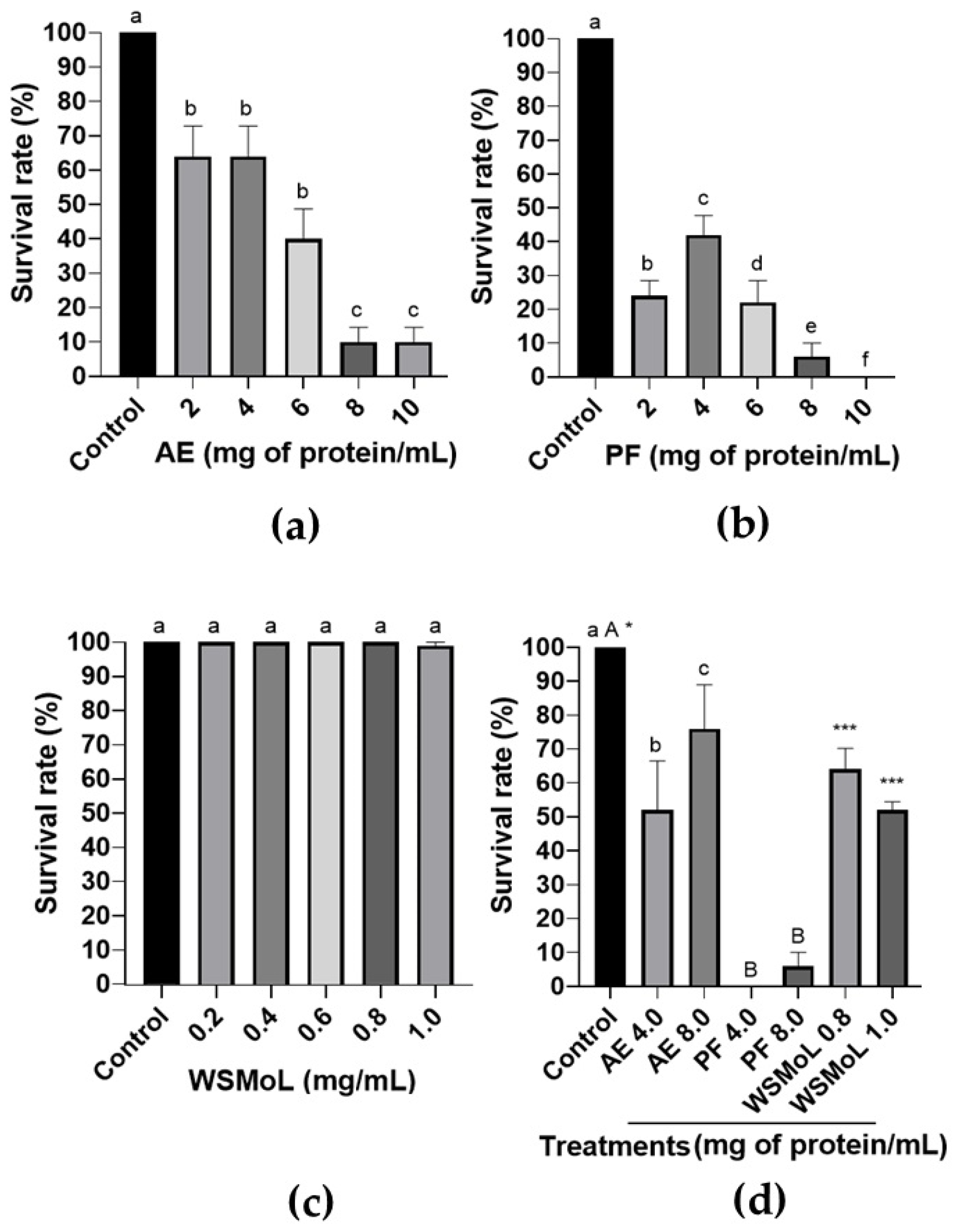
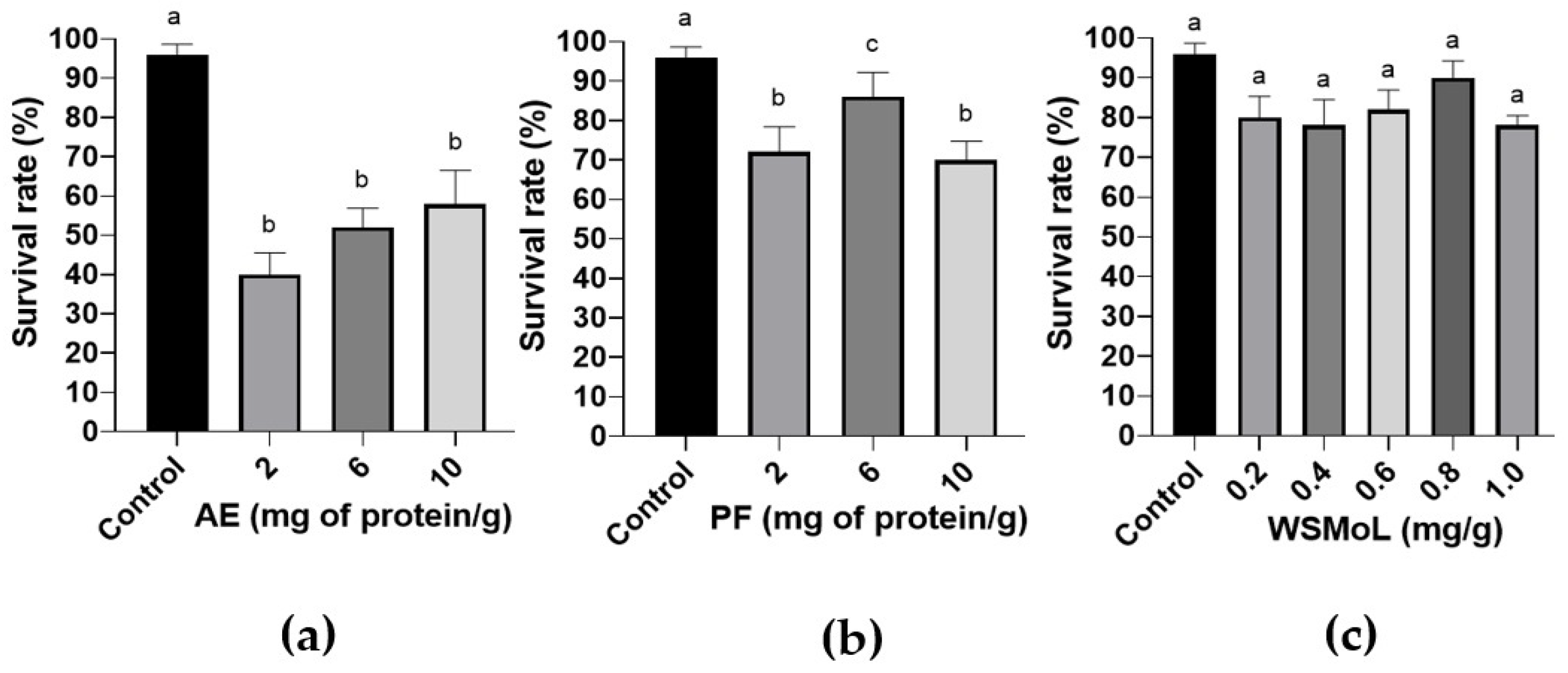

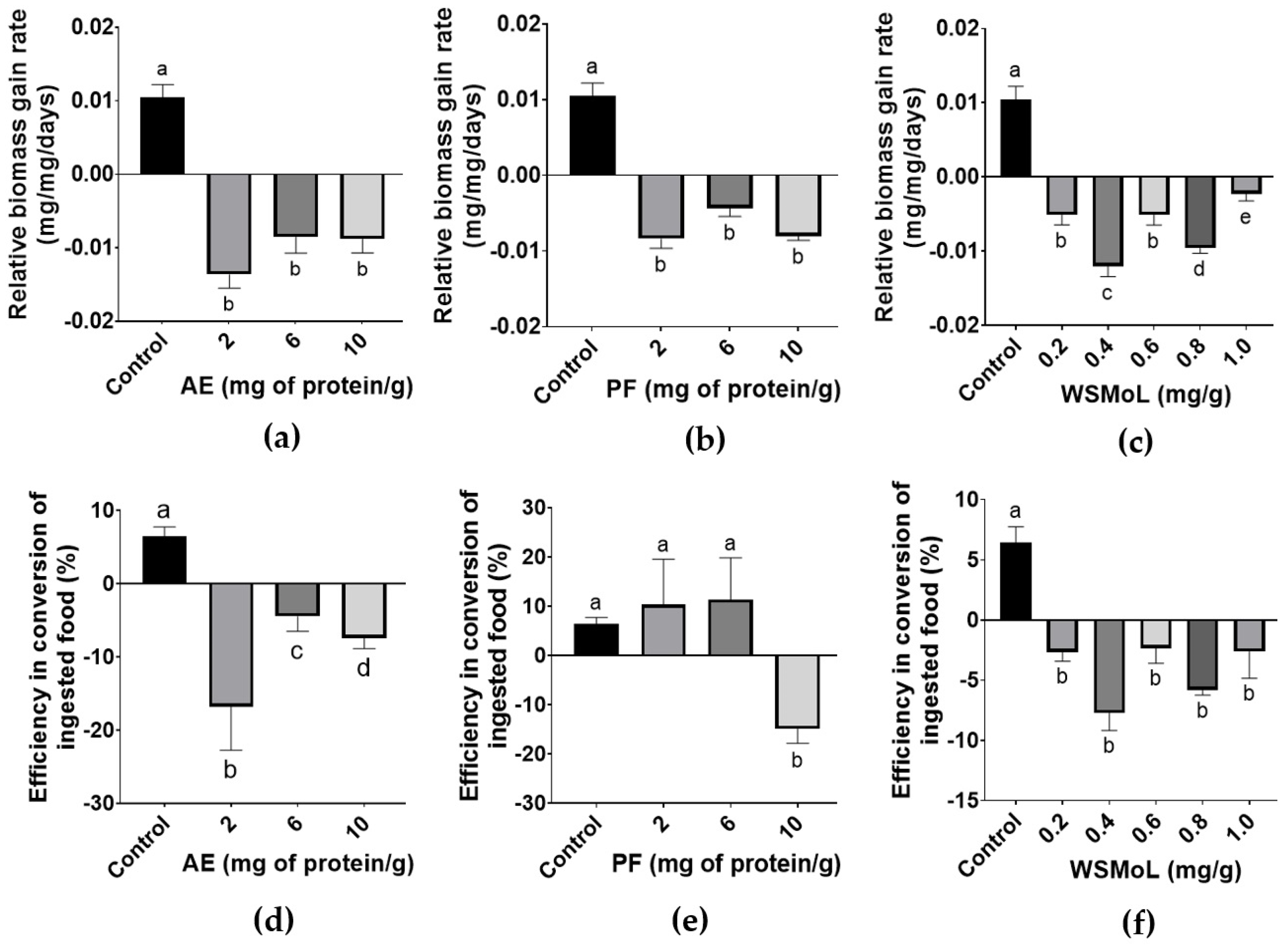
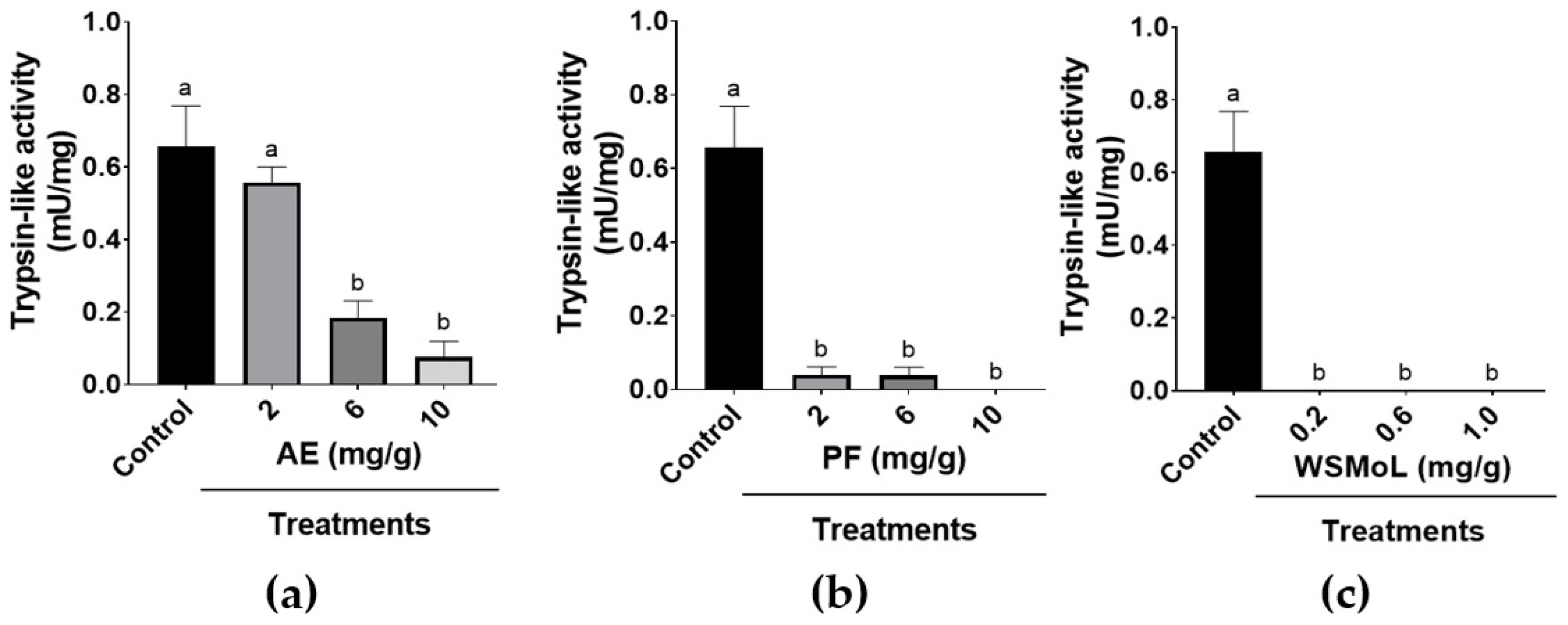
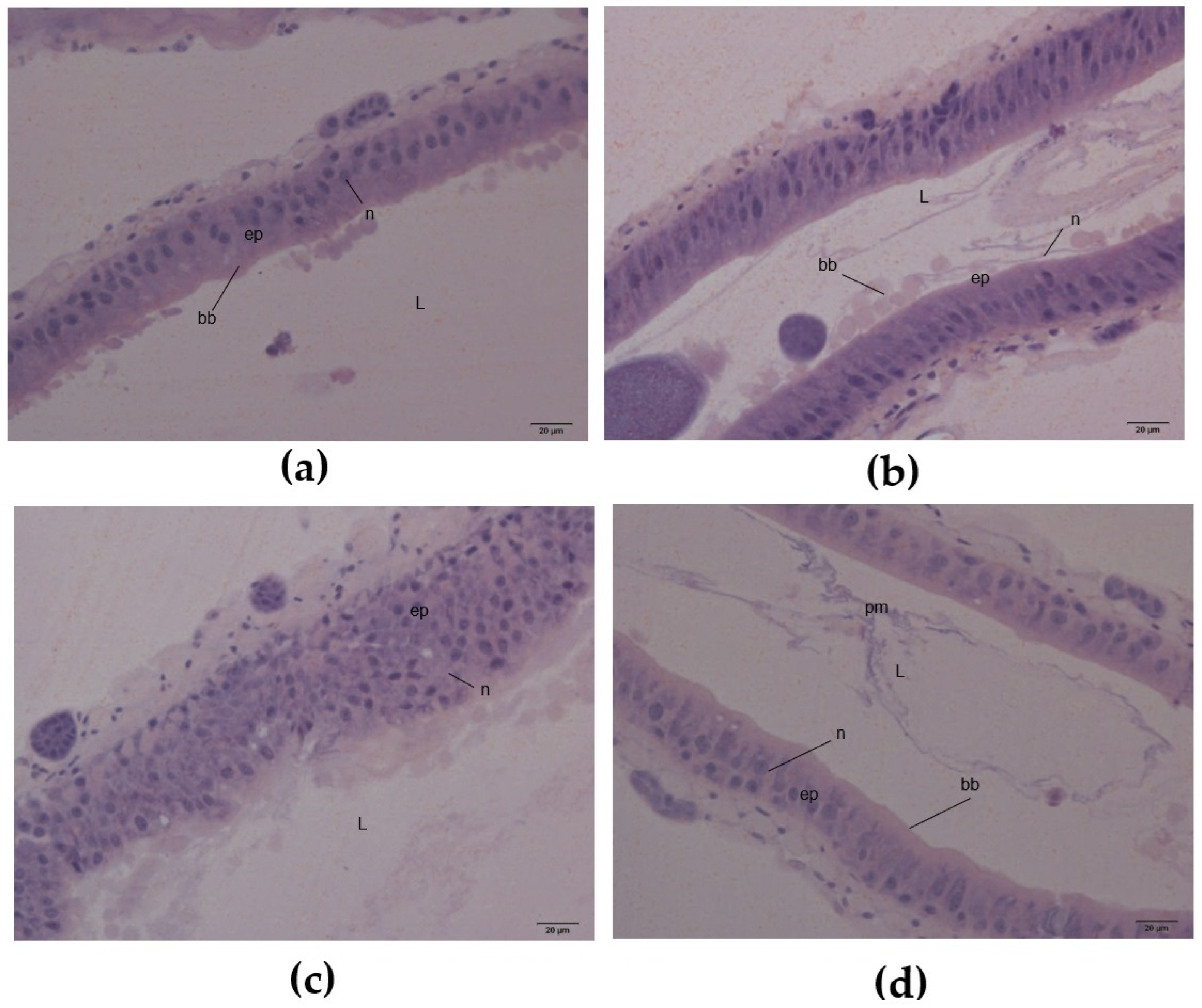
Disclaimer/Publisher’s Note: The statements, opinions and data contained in all publications are solely those of the individual author(s) and contributor(s) and not of MDPI and/or the editor(s). MDPI and/or the editor(s) disclaim responsibility for any injury to people or property resulting from any ideas, methods, instructions or products referred to in the content. |
© 2025 by the authors. Licensee MDPI, Basel, Switzerland. This article is an open access article distributed under the terms and conditions of the Creative Commons Attribution (CC BY) license (https://creativecommons.org/licenses/by/4.0/).
Share and Cite
Santos, N.D.d.L.; dos Santos, P.É.M.; Lira, T.L.d.S.; Santos, A.R.d.S.; Silva, J.N.d.O.; dos Santos, A.N.S.; de Amorim, M.M.R.; Barros, M.R.; Coelho, L.C.B.B.; Paiva, P.M.G.; et al. Insecticidal Activity of Lectin Preparations from Moringa oleifera Lam. (Moringaceae) Seeds Against Alphitobius diaperinus (Panzer) (Coleoptera: Tenebrionidae). Plants 2025, 14, 511. https://doi.org/10.3390/plants14040511
Santos NDdL, dos Santos PÉM, Lira TLdS, Santos ARdS, Silva JNdO, dos Santos ANS, de Amorim MMR, Barros MR, Coelho LCBB, Paiva PMG, et al. Insecticidal Activity of Lectin Preparations from Moringa oleifera Lam. (Moringaceae) Seeds Against Alphitobius diaperinus (Panzer) (Coleoptera: Tenebrionidae). Plants. 2025; 14(4):511. https://doi.org/10.3390/plants14040511
Chicago/Turabian StyleSantos, Nataly Diniz de Lima, Patryck Érmerson Monteiro dos Santos, Thiago Lucas da Silva Lira, Aline Rodrigues da Silva Santos, Juliane Nancy de Oliveira Silva, Alícia Natalie Silva dos Santos, Marcus Mello Rego de Amorim, Mércia Rodrigues Barros, Luana Cassandra Breitenbach Barroso Coelho, Patrícia Maria Guedes Paiva, and et al. 2025. "Insecticidal Activity of Lectin Preparations from Moringa oleifera Lam. (Moringaceae) Seeds Against Alphitobius diaperinus (Panzer) (Coleoptera: Tenebrionidae)" Plants 14, no. 4: 511. https://doi.org/10.3390/plants14040511
APA StyleSantos, N. D. d. L., dos Santos, P. É. M., Lira, T. L. d. S., Santos, A. R. d. S., Silva, J. N. d. O., dos Santos, A. N. S., de Amorim, M. M. R., Barros, M. R., Coelho, L. C. B. B., Paiva, P. M. G., Lima, T. d. A., Martins, G. F., Napoleão, T. H., & Pontual, E. V. (2025). Insecticidal Activity of Lectin Preparations from Moringa oleifera Lam. (Moringaceae) Seeds Against Alphitobius diaperinus (Panzer) (Coleoptera: Tenebrionidae). Plants, 14(4), 511. https://doi.org/10.3390/plants14040511








